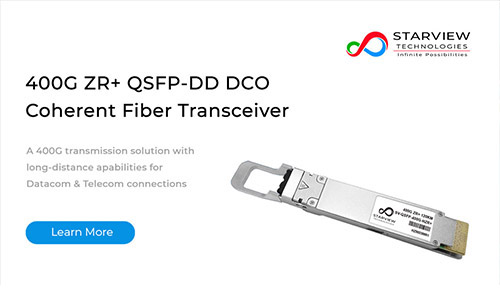- SOLUTIONS
- PRODUCTS
- SERVICES
- PARTNERS
- RESOURCES
400G DCO QSFP56-DD ZR and ZR+ Optical Module

400G PAM4 Ethernet Transceivers – Introduction

Elevate Your Storage Solutions with GRAID and NVMe/TCP
400G DCO QSFP56-DD ZR and ZR+ Optical Module
In our last newsletter, we shared about 400G PAM4 Ethernet and 400G QSFP56-DD transceivers. Today we will share on the 400G Digital Coherent Optics (DCO), which offers direct connectivity to dense wavelength division multiplexing (DWDM) C-Band networks, OTN networks and extended long range connectivity.
Digital Coherent Optics (DCO) are optical transceivers that use coherent modulation and DSP (Digital Signal Processor) to transport high data rate signals over long distances via a fiber optic cable. Coherent optical transmission manipulates three different light properties: amplitude, phase, and polarization, to allow faster optical signal transfer without compromising the transmission distance. Essentially, coherent optics take the ones and zeroes in a digital signal and modulates the phase and amplitude to allow more data to be transmitted across polarizations, resulting in a coherent advantage.
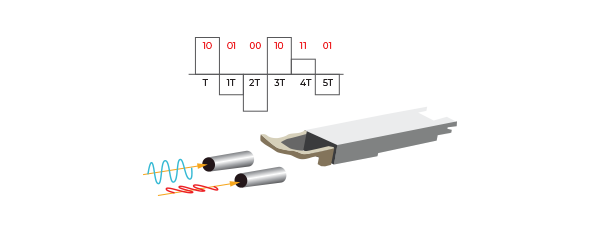
Figure 1: 400G DCO QSFP-DD
Some of the common terms use in coherent optics are Modulation and Baud rate:
Modulation
Unlike 400G PAM4 Ethernet, coherent QSFP-DD uses coherent modulation (QPSK/QAM) instead of amplitude modulation (NRZ/PAM4) for establishing higher bandwidth (400G/800G Ethernet). Quadrature Phase Shift Keying (QPSK) arose first and is a system of modulating digital signals onto a radio-frequency carrier signal using four phase 0, 90, 180, 270-degree states to code two digital bits. Then Quadrature Amplitude Modulation (QAM) came about to combine two amplitude-modulated (AM) signals into a single channel, thereby doubling the effective bandwidth. QAM is used with pulse amplitude modulation (PAM) in digital systems.
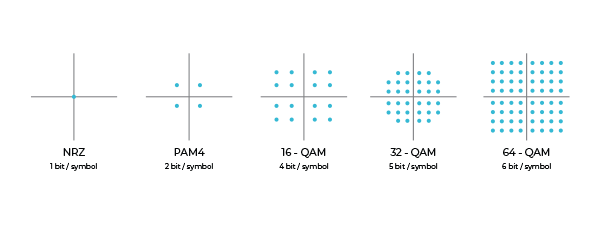
Figure 2: Coherent Optics Modulation vs PAM4 vs NRZ
- DP-QPSK Coherent Optics Modulation
Dual Polarization Quadrature Phase-Shift Keying (DP-QPSK) is a modulation technique used in optical communication that encodes four bits per symbol. It uses four different phases as well as two polarizations (vertical and horizontal). When a DP-QPSK symbol is sent, information for four bits is transmitted. DP-QPSK is commonly used in long-distance 400G coherent optics lines and typically requires a coherent optical receiver.
- 16-QAM Coherent Optics Modulation
16-QAM is a kind of Quadrature Amplitude Modulation (QAM) in which a carrier wave with a given frequency can exist in one of sixteen different states, each represented by a symbol containing one of sixteen alternative amplitude and phase values. The 16-QAM modulation carrier wave with a given frequency can exist in one of sixteen distinct and measurable states in the constellation plot. The QAM technology allows alteration of both the amplitude and phase of the carrier signal. In 16-QAM, each symbol represents four bits and is commonly used in 400G coherent optics lines, while 64-QAM is used in 800G coherent optics lines.
Baud rate
Baud rate refers to the total symbols transmitted per unit of time. Essentially, it measures how many times the signal alters its state in a second. A 400G 16-QAM modulation allows transport of four bits per symbol, and the capacity is doubled with polarization. A transceiver sending 64GBaud pulses per second (64 billion pulses per second) and operating at 16QAM is sending approx. 100 billion bits per second of data.

Figure 3: Constellation diagram of 16-QAM
With innovation of DSP and advanced chipsets, the 400G DCO can now be integrated within a QSFP-DD form factor. The DSP consumes approx. 50% of power from the optics, and performs many important functions of the coherent signal. It also compensates dispersion and distortion with in-built DCM (Dispersion Compensation Module) for long distance transmission.
Coherent Optics standards
The 400G coherent technology adheres to standards to enable interoperating among different vendors in the optical network. Table 1 gives an overview of the comparison of these standards:
Standards | OIF 400G ZR | Open ZR+ MSA |
Optical Reach | <120km | Up to 400km (400G) |
Client Interface | 400G Ethernet | 100G to 400G Ethernet |
Modulation | 16QAM | QPSK, 8QAM, 16QAM |
Baud Rate | ~60GBaud | 100G: 30GBaud 200G – 400G: 60GBaud |
Tx Power | -10dBm | -10dBm |
Client Interface | 100GE, 400GE | 100GE, 400GE |
Power | 15-20W | 18-20W |
Variants of 400G Digital Coherent QSFP-DD transceivers
Starview provides the 400G coherent optics shown in table 2:
400G ZR | 400G ZR+ | 400G ZR++ | |
Starview Part No | |||
Standards | OIF 400G ZR | Open ZR+ MSA | Open ZR+ MSA |
Client traffic | 100G, 400G Ethernet | 100G to 400G Ethernet, OTU-4 | 100G to 400G Ethernet, OTU-4 |
Line Rate | 400G Ethernet | 100G to 400G Multi rate, OTU-4 | 100G to 400G Multi rate, OTU-4 |
DWDM wavelength | Tuneable C-Band | Tuneable C-Band | Tuneable C-Band |
Distance | <=120km | >120km | >120km |
Transmit (Tx) Power | -10.0 to -6.0dBm | -10.0 to -6.0dBm | -5.0 to +3.0dBm |
Receiver (Rx) Sensitivity | -20.0 to 0dBm | -20.0 to 0dBm | -24.0 to 12.0dBm |
400G ZR
400G ZR is compliant with the Optical Internetworking Forum OIF-400ZR standard, and allows transmission of a 400G ethernet over a single optical wavelength. The typical budget of the 400G ZR is 10dB/ 40km for point-to-point transmission. When combine with a DWDM Mux/Demux and EDFA (Erbium-doped optical fiber amplifier), it can reach up to 120 km as shown in figure 4. The 400G ZR is also commonly referred as IP-over-DWDM, since it allows simple connection to 400G switches inside data centers.
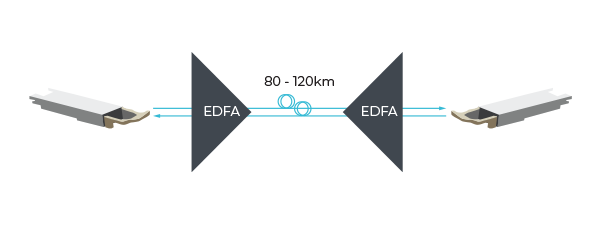
Figure 4: 400G ZR Application
400G ZR+
While 400G ZR is suitable for data center providers, telecom network operators require a more flexible 400G optics to transport over their Reconfigurable Optical Add-Drop Multiplexers (ROADMs). Open ZR+ Multi-Source Agreement (MSA) allows the 400G ZR+ with features like 400G ZR to support OTN (Optical Transport Network). Due to its enhanced features and performance, it is used in many applications such as extended point-to-point transmission, Metro/ Regional OTN, and multi-vendor ecosystems.
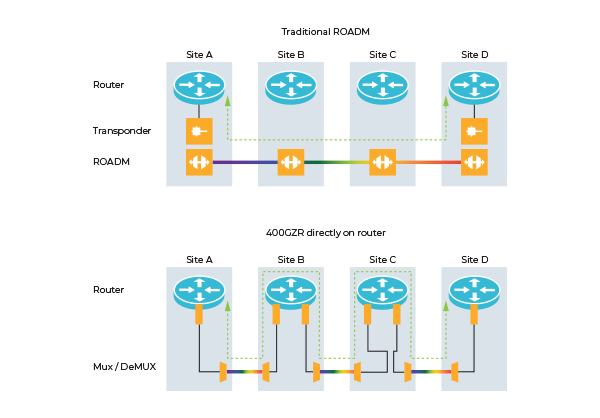
Figure 5: 400G ZR+ Application
400G HZR+
400G HZR+ is an enhanced version of the 400G ZR+ that features higher Transmit (Tx) power and higher Receiver (Rx) sensitivity as shown in table 2 above.
When considering an optical link with amplification, it is essential to consider the OSNR (Optical Signal to Noise Ratio) factor for the transmission. Noise can be induced into the fiber (e.g. Patching or equipment) and amplified as a signal, which can cause error in the transmission.
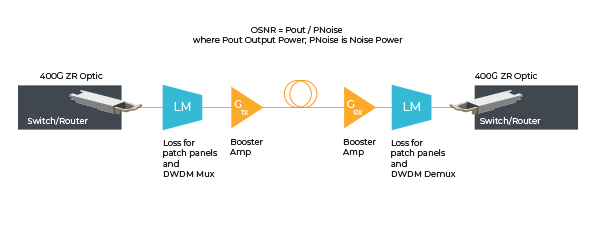
Figure 6: OSNR of an amplified link
Conclusion
The 400G DCO QSFP-DD offers a versatile and cost-effective solution for enabling high-speed, long-distance data transmission in optical networks. With scalability, interoperability, and advanced features, it meets the evolving demands of modern communications infrastructure.
400G DCO QSFP-DD are best used in aggregation and long-haul transmission networks, especially to transmit longer distance of 80km and above, or integrate with DWDM networks; For distance below 80km, it is recommended to use 400G PAM4 Ethernet.
About Starview
The advancements in coherent optics present a challenging environment for customers to deploy and use them especially when amplification is required. It entails optical knowledge of fiber optic transmission, and special optical testers for diagnostics. Starview has more than 10 years of networking experience, and is capable to design the network, and support the high-speed optics with your existing equipment and infrastructure.
To learn more about Starview’s product lineup, explore our E-Catalog or contact us at sales@starviewtech.net. Embrace the power of long-haul data transmission with Starview.

